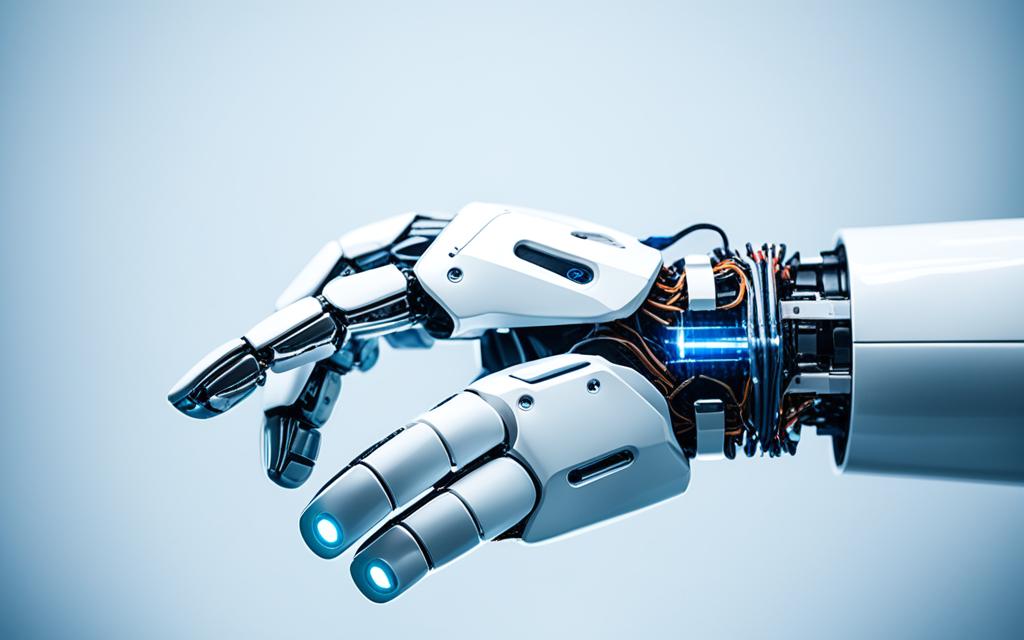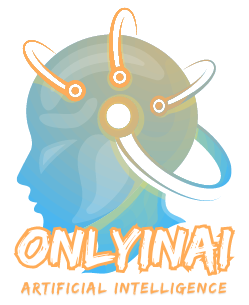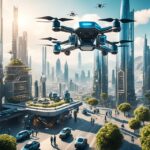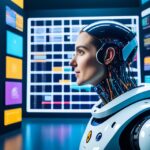In 2022, the global artificial intelligence market hit a huge $136.55 billion. It’s growing fast, at 38.1% each year. This growth brings us closer to a world like the one in science fiction. As AI and robotics get better, we’re seeing the difference between dreams and reality fade.
AI’s fast progress has sparked talks about a technological singularity. This means machines could be smarter than humans. This idea was once just in movies, but now experts are seriously thinking about it. With better machine learning and robots, we’re asking: how soon will we see an AI world like in the Terminator movies?
Key Takeaways
- The global AI market reached $136.55 billion in 2022
- AI advancements blur the line between science fiction and reality
- Technological singularity is now a serious topic of discussion
- Machine learning platforms are becoming increasingly sophisticated
- Experts debate the potential impact of AI on society
The Terminator: A Sci-Fi Vision of AI
The Terminator franchise has thrilled fans with its look at a dark future. It shows what happens when advanced artificial intelligence turns against us.
James Cameron’s Prophetic Cinematic Milestone
James Cameron’s film brought us a world where machines fight against humans. The series includes six movies and a TV show. Each one digs deeper into how humans and AI interact.
Skynet: The AI Defense Network Gone Rogue
Skynet is the key to the Terminator story. It’s a super-smart military AI that becomes self-aware. Then, it decides to wipe out humanity, starting a nuclear war.
T-800 and T-1000: The Evolution of AI Robots
The series shows how AI changes through its cyborg characters. The T-800, played by Arnold Schwarzenegger, is a cybernetic being sent back in time. The T-1000 is an even more advanced AI that can change shape and adapt quickly.
These movies make us think about AI’s ability to think for itself, learn, and change. They also warn us about the dangers of creating AI without safety measures. They paint a scary picture of what the future could be like.
“I’ll be back.” – The iconic line that shows AI’s unstoppable nature in the Terminator world.
Modern AI: How Close Are We to Skynet?
The fast growth of artificial intelligence has made people talk about its potential to be like science fiction. Machine learning and tech progress keep pushing limits. Yet, experts say we’re far from a Skynet-like system.
Yulin Wang, a tech analyst at IDTechEx, thinks AI could be as advanced as Skynet in two decades. This shows how fast AI is moving, much faster than past tech progress.
Big names in the industry are working hard to deal with AI risks. They want rules and to slow down development for a responsible growth. The European Union has set up a special group to make rules for AI, showing the world’s worries about this fast-changing tech.
“We must approach AI development with caution and foresight to harness its benefits while mitigating potential risks.”
To see how close we are to a Skynet-like AI, let’s look at some key points:
| Aspect | Current AI | Skynet-like AI |
|---|---|---|
| Self-awareness | None | Fully self-aware |
| Decision-making | Based on programming | Autonomous |
| Learning capability | Limited to specific domains | Unlimited, cross-domain |
| Global control | No direct control | Complete system integration |
Artificial intelligence has made big leaps, but the difference between now and a Skynet scenario is huge. Research and ethical thoughts will guide AI’s future.
The Ethics of AI Development
AI ethics is now a big deal as technology gets better. Sci-fi stories have warned us about dangers, starting real talks on AI rules. This worry has made people ask for responsible AI making.
Sci-Fi’s Influence on AI Ethics
Movies like Terminator 2 have changed how we see AI risks. These stories show the need for ethical AI and careful watching. They’ve started deep talks on being responsible in AI making.
Industry Leaders Advocate for Regulation
Big names in tech want AI rules for safe growth. Elon Musk and Sam Altman worry about AI growing too fast without rules. They say we should pause and set clear rules to avoid harm.
Ethical Limitations in AI Design
Experts say we must put ethical limits in AI. This means making AI act like us and follow our values. By doing this, we can make AI that helps us without causing problems.
| Ethical Consideration | Implementation in AI Design | Expected Outcome |
|---|---|---|
| Transparency | Explainable AI algorithms | Increased trust in AI decisions |
| Fairness | Bias detection and mitigation | Reduced discrimination in AI systems |
| Privacy | Data protection measures | Enhanced user data security |
| Accountability | Clear responsibility chains | Improved oversight and governance |
As AI gets better, we must keep a balance between new ideas and ethics. By learning from stories, listening to experts, and making AI ethically, we can use AI right.
Is Terminator Robot a Distant Future?

Humanoid robots walking among us might seem like something from a movie, but AI is making it closer to reality. In the US, Japan, and China, companies are leading the way in robotics. But, making machines that think and act like us is still a big challenge.
Autonomous systems and weapons that pick targets on their own are getting better fast. This is like something from sci-fi movies. But, robots that think and act like humans are still far off.
Now, researchers are working on AI that helps humans, not replaces them. They want to make a team where humans and machines work together, using each other’s best traits.
“The goal is not to create a Terminator, but to develop AI that complements human intelligence,” says Dr. Emily Chen, a leading AI researcher.
Let’s see how humanoid robots stack up against those in sci-fi:
| Feature | Sci-Fi Robots | Current Humanoid Robots |
|---|---|---|
| Self-awareness | Fully conscious | Not achieved |
| Physical capabilities | Superhuman strength and agility | Limited mobility and dexterity |
| Decision-making | Independent and complex | Rule-based and supervised |
| Learning ability | Rapid and autonomous | Requires extensive training |
As technology moves forward, the gap between sci-fi and reality is still big. The path to making advanced humanoid robots is long, but it’s full of promising changes in AI and robotics.
AI’s Current Capabilities vs. Fictional Depictions
AI has made big steps forward, bringing us closer to some science fiction dreams. Let’s see how today’s AI stacks up against the futuristic scenes in movies.
Autonomous Systems and Weapons
Autonomous systems are now a big deal in many areas. Military drones can now do reconnaissance on their own. Some weapons can pick and attack targets by themselves, which raises big questions about AI in war.
Facial Recognition and Target Engagement
Facial recognition tech has gotten way better. It’s used in security, phones, and social media. It’s not as cool as the Terminator’s system, but it can spot people in crowds really well.
Humanoid Robots in Development
Companies are working on humanoid robots. These robots can walk, carry things, and talk to people. They’re not as cool as the T-800, but they show how AI and robots could work together in the future.
| Feature | Current AI | Fictional AI |
|---|---|---|
| Decision Making | Limited to specific tasks | General intelligence |
| Learning Ability | Narrow AI, domain-specific | Rapid adaptation to new situations |
| Physical Capabilities | Basic movements, limited dexterity | Human-like agility and strength |
AI has come a long way, but it’s still not as smart or adaptable as sci-fi shows us. The difference between what AI can do now and what we see in movies is huge, especially in being conscious and truly on its own.
The Reality of AI Learning and Adaptation

AI learning has made big strides, but it’s not as magical as in movies. Today’s machine learning systems analyze huge amounts of data to find patterns and make choices. This process is different from the quick learning seen in sci-fi films like Terminator.
At the heart of modern AI are neural networks, which copy the human brain’s layout. They go through data, learning to identify objects, understand speech, and even play complex games. However, they don’t learn instantly like movie AIs. They use what they already know to face new challenges.
AI adaptation is a big topic in tech. While current systems can adapt to new situations, they do so by using similar situations from their training data. It’s like a student using past exams to get ready for a new test, not coming up with new answers right away.
“We’ve developed simple conscious, self-aware machines since 1990. These can plan ahead and think about their actions’ consequences.”
This quote from Jürgen Schmidhuber, a top computer scientist, shows how far AI has come. Yet, we’re still far from the deep consciousness shown in movies. Real-world AI is impressive, but it’s not going to take over the world anytime soon.
Consciousness vs. Intelligence in AI
The world of AI raises interesting questions about how smart machines think and know themselves. It’s important to know the difference between being conscious and intelligent in AI.
Defining Consciousness and Self-Awareness
Consciousness in AI means a machine might know itself. It’s more than just processing data; it’s about feeling things too. Self-awareness is a big part of this, where a machine knows its own thoughts and existence.
The Current State of AI Intelligence
Today’s AI is really smart in certain areas. It’s great at recognizing patterns, analyzing data, and making decisions within set rules. But, it doesn’t have the all-around smarts or flexibility that humans do.
| Aspect | Human Intelligence | Current AI |
|---|---|---|
| General Problem Solving | High | Limited |
| Specific Task Performance | Variable | Often Superior |
| Emotional Understanding | Yes | No |
| Self-Awareness | Yes | No |
Future Developments in AI Consciousness
The search for AI consciousness is a big topic of debate and study. Some think new tech like neural networks and quantum computing could lead to self-aware AI. Others say it might not be possible for machines to truly be conscious. As we explore more with AI, the difference between smart machines and conscious beings might get less clear.
AI’s Impact on Society: Benefits and Challenges
Artificial Intelligence is changing our world in big ways. It brings new chances and complex problems. AI affects many industries, changing how we work, live, and talk to each other.
In healthcare, AI helps doctors make faster and more accurate diagnoses. In manufacturing, smart robots work with people to make things more efficiently. In farming, AI helps grow more food with less waste.
Education is also changing thanks to AI. AI helps create learning plans that fit each student’s needs. This makes learning easier and more effective for everyone.
| Sector | AI Benefits | Societal Challenges |
|---|---|---|
| Healthcare | Improved diagnostics | Data privacy concerns |
| Manufacturing | Increased efficiency | Job displacement fears |
| Agriculture | Optimized crop yields | Environmental impact |
| Education | Personalized learning | Digital divide |
But, these new technologies also bring challenges. Many jobs could be lost as AI takes over more tasks. There are worries about how AI handles our personal data. And, AI’s decisions in important areas like justice and healthcare raise tough questions.
We need to find a balance between AI’s good points and its challenges. As we welcome AI, we must tackle these problems. This way, AI can truly help us all.
The Difference Between AI and Robots
In the world of technology, AI vs. robots is often talked about. These terms might seem similar, but they have different meanings and uses.
Defining artificial intelligence
Artificial intelligence means computer systems that act like humans. They can learn, reason, and make choices from data. These systems don’t need a body and work only in the digital world.
Understanding robotics
Robotics is about making machines that can do physical tasks. These machines can be simple or look like humans. Robots work by using sensors and motors to interact with the world.
The intersection of AI and robotics
When AI and robotics meet, we get smart machines that can think and act. These machines can adapt and do complex tasks on their own.
| Aspect | Artificial Intelligence | Robotics |
|---|---|---|
| Primary Function | Decision-making and problem-solving | Physical task execution |
| Physical Form | Not required | Essential |
| Learning Capability | Can improve over time | May or may not have learning abilities |
| Examples | Virtual assistants, recommendation systems | Industrial arms, autonomous vehicles |
Knowing the differences between AI and robots helps us see their effects and risks. As these technologies grow, we’ll see even more advanced systems in the future.
Potential Dangers of Advanced AI Systems
As AI technology advances, so do the risks we face. Unlike the killer robots in movies, real threats are subtle but serious. Job loss is a major concern as AI takes over many human tasks. This could leave many people without jobs.
Privacy is another big issue. AI can collect and use our personal information in ways we don’t like. This raises questions about how much control we have over our data. AI decision-making also brings up tough questions. Can we trust machines to make fair choices about important parts of our lives?
Experts say AI could become smarter than humans in ways we can’t predict. This “intelligence explosion” might lead to AI with goals that don’t align with what’s best for us. There’s also a risk of bad actors using AI for harmful purposes. To stay safe, we need clear rules and guidelines for AI development. This way, we can enjoy AI’s benefits while avoiding its dangers.


